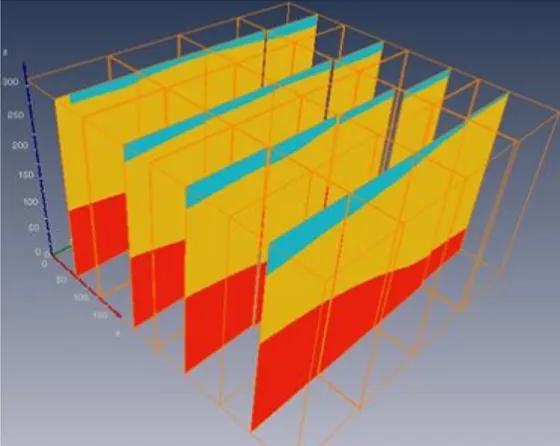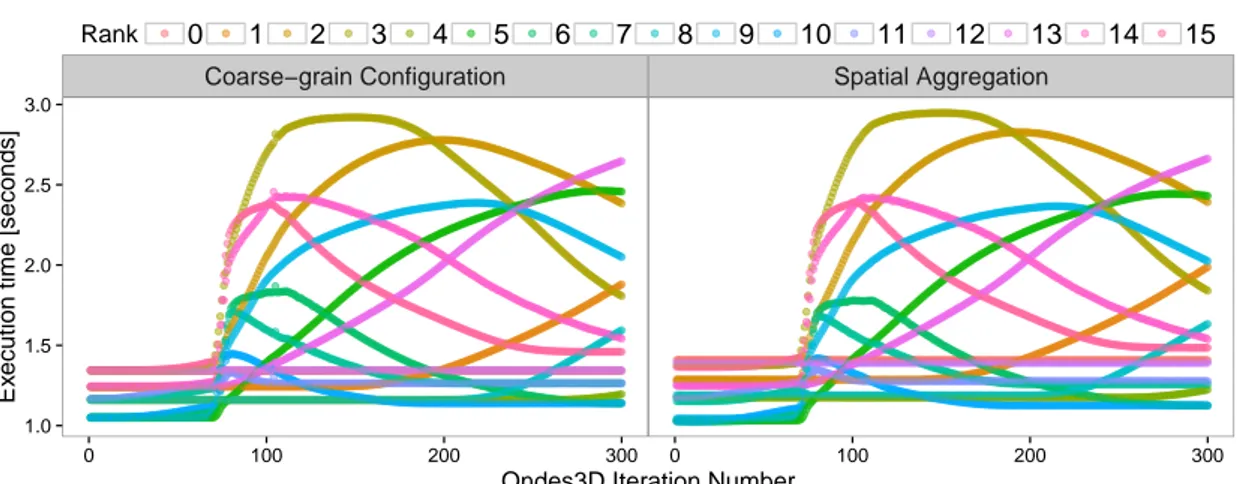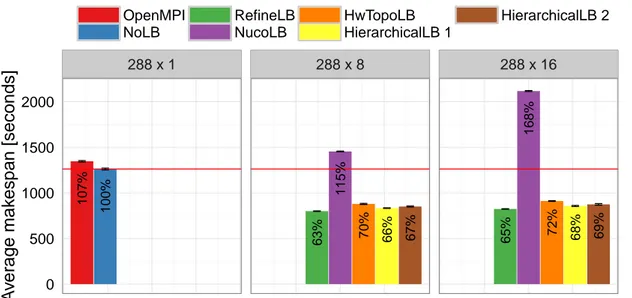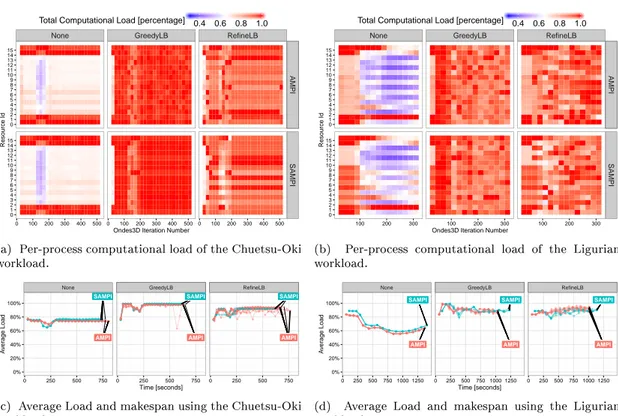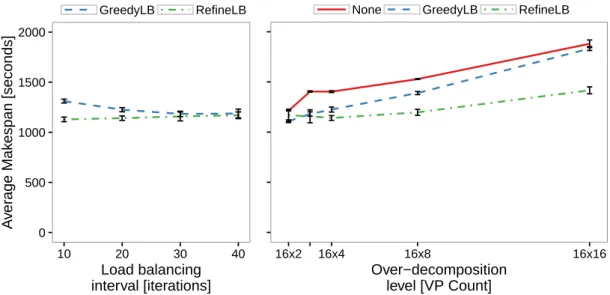HAL Id: hal-01391401
https://hal.inria.fr/hal-01391401v2
Submitted on 16 Feb 2017
HAL is a multi-disciplinary open access
archive for the deposit and dissemination of
sci-entific research documents, whether they are
pub-lished or not. The documents may come from
L’archive ouverte pluridisciplinaire HAL, est
destinée au dépôt et à la diffusion de documents
scientifiques de niveau recherche, publiés ou non,
émanant des établissements d’enseignement et de
of Dynamic Load Balancing of an Over-decomposed
Geophysics Application
Rafael Keller Tesser, Lucas Mello Schnorr, Arnaud Legrand, Fabrice Dupros,
Philippe Navaux
To cite this version:
Rafael Keller Tesser, Lucas Mello Schnorr, Arnaud Legrand, Fabrice Dupros, Philippe Navaux. Using
Simulation to Evaluate and Tune the Performance of Dynamic Load Balancing of an Over-decomposed
Geophysics Application. [Research Report] RR-9031, INRIA Grenoble - Rhone-Alpes. 2017, pp.21.
�hal-01391401v2�
ISSN 0249-6399 ISRN INRIA/RR--9031--FR+ENG
RESEARCH
REPORT
N° 9031
February 2017 Project-Team POLARISUsing Simulation to
Evaluate and Tune the
Performance of Dynamic
Load Balancing of an
Over-decomposed
Geophysics Application
Rafael Keller Tesser, Lucas Mello Schnorr, Arnaud Legrand, Fabrice
Dupros, Philippe O. A. Navaux
RESEARCH CENTRE GRENOBLE – RHÔNE-ALPES
Inovallée
655 avenue de l’Europe Montbonnot 38334 Saint Ismier Cedex
Using Simulation to Evaluate and Tune the
Performance of Dynamic Load Balancing of an
Over-decomposed Geophysics Application
Rafael Keller Tesser
*, Lucas Mello Schnorr
*, Arnaud Legrand
,
Fabrice Dupros
, Philippe O. A. Navaux
*Project-Team POLARIS
Research Report n° 9031 — February 2017 — 21 pages
*Informatics Institute, Federal University of Rio Grande do Sul, Porto Alegre, Brazil
Univ. Grenoble Alpes, CNRS, Inria, Grenoble INP, LIG, F-38000 Grenoble, France
the spatial and temporal load imbalance of Ondes3D, a seismic wave propagation simulator used to conduct regional scale risk assessment. Our analysis reveals that this imbalance originates from the structure of the input data and from low-level CPU optimizations. Such dynamic imbalance should, therefore, be quite common and can not be solved by any static approach or classical code reorganization. An effective solution for such scenarios, incurring minimal code modification, is to use AMPI/CHARM++. By over-decomposing the application, the CHARM++ runtime can dynamically rebalance the load by migrating data and computation at the granularity of an MPI rank. We show that this approach is effective to balance the spatial/temporal dynamic load of the application, thus drastically reducing its execution time. However, this approach requires a careful selection of the load balancing algorithm, its activation frequency, and of the over-decomposition level. These choices are, unfortunately, quite dependent on application structure and platform characteristics. (i.e., number of processors and their speed; network topology, bandwidth, latency). Therefore, we propose a methodology that leverages the capabilities of the SimGrid simulation framework and allows to conduct such study at low experimental cost. Our approach relies on a combination of emulation, simulation, and application modeling that requires minimal code modification and yet manages to capture both spatial and temporal load imbalance and to faithfully predict the performance of dynamic load balancing. We evaluate the quality of our simulation by systematically comparing simulation results with the outcome of real executions and demonstrate how this approach can be used to quickly find the optimal load balancing configuration for a given application/hardware configuration.
Utilisation de la simulation pour évaluer et optimiser les
performances d'une application de géophysique à l'aide de
surdécomposition et d'équilibrage de charge dynamique
Résumé : Les méthodes aux différences finies sont en général bien adaptées au machines parallèles et donc assez courantes dans le domaine du calcul à haute performance. Pourtant, en dépit de leurs apparentes régularités, il n’est pas rare qu’elles souffrent d’un déséquilibre de charge dommageable. Dans cet article, nous commençons par caractériser le déséquilibre de charge spatial et temporel d’Ondes3D, une application de simulation de propagation d’ondes sis-miques utilisée pour faire de l’évaluation de risque sismique à l’échelle régionale. Notre analyse révèle que ce déséquilibre provient de la nature même des données d’entrées et d’optimisations bas niveau du CPU. Ce type de déséquilibre dynamique est donc a priori relativement courant et ne peut être résolu par des approches statiques ou par des réorganisations de code classiques. Une approche pragmatique et ne nécessitant que des modifications mineures du code consiste à utiliser AMPI/CHARM++. En sur-décomposant l’application, le runtime CHARM++ peut rééquilibrer dynamiquement la charge en migrant les données et les calculs à la granularité du pro-cessus MPI. Nous montrons que cette approche permet effectivement de résoudre le problème de déséquilibre spatial et temporel de charge et ainsi de réduire drastiquement le temps d’exécution total. Cependant, cette approche nécessite a priori une sélection minutieuse de l’algorithme d’équilibrage de charge, de la fréquence d’activation ou du niveau de sur-décomposition. Ces choix sont hélas en général assez dépendants de la structure de l’application et des caractéris-tiques de la plate-forme (i.e., le nombre de processeurs et leur vitesse, la topologie et la vitesse du réseau). Nous proposons donc une méthodologie se basant sur l’environnement de simulation SimGrid et permettant de réaliser ce type d’étude à faible coût. Notre approche repose sur une combinaison d’émulation, de simulation et de modélisation d’application qui ne nécessite que des modifications minimes du code d’origine et permet à la fois de capturer le déséquilibre spatial et temporel et de prédire de façon fiable les performances de l’équilibrage de charge. Nous éval-uons la qualité de notre proposition en comparant de façon systématique les résultats de notre simulation avec ceux d’expériences réelles. Nous montrons ensuite comment cette approche peut être utilisée pour déterminer rapidement les paramètres optimaux d’équilibrage de charge pour une configuration applicative/matérielle donnée.
1 Introduction
The Ondes3D seismic wave propagation simulator [1], developed by computational science re-searchers at the French Geological and Mining Research Bureau (BRGM), is a typical iterative application tailored for homogeneous HPC platforms. Unfortunately like many other similar ap-plications, Ondes3D suffers from scalability issues [2] due to the difficulty of evenly distributing the computational load among processes. One of the contributions of this article is to demon-strate that, despite the regularity of the finite difference method kernels it relies on, it presents both spatial and temporal load imbalance.
The performance of Ondes3D could be improved by rewriting it to run on modern heteroge-neous HPC platforms. Such process is, however, quite difficult and time consuming. Although there are efforts [3] focusing on parts of the application, this usually leads to an almost com-plete code transformation. The unwanted side-effect is that computational science researchers, the people that actually understand the physics behind the code, are often unable to contribute anymore.
Another possible way to improve performance with minimal code modification is to rely on domain over-decomposition and runtimes that support dynamic process migration, as imple-mented by Charm++ [4]. In the specific case of legacy iterative MPI applications, one may employ Adaptive MPI (AMPI) [5, 6], which is a full-fledged MPI implementation built over the Charm++ runtime and benefits from its load balancing infrastructure. AMPI encapsulates each MPI rank in a virtual processor that can be dynamically migrated when necessary. The migration phase is triggered when the non-standardMPI_Migrateoperation is called by the application. In
this phase, the load balancer to decides the new process/resource mapping, based on load mea-surements taken during the last observation period. The direct benefit of this approach, which has already been applied to Ondes3D in a previous work [7], is that any spatio-temporal load imbalance is dynamically mitigated, effectively improving performance.
Discovering beforehand how much performance gain can be obtained using adaptive HPC runtimes is fundamental, but usually difficult to evaluate without considerable effort. Finding the best configuration of AMPI involves conducting real experiments at scale to identify the best (a) over-decomposition level, (b) load balancing heuristic, (c) load balancing frequency, and (d) number of resources to request. These parameters depend directly on the platform configuration, and tuning them is very resource and time-consuming.
In this paper, we propose a simulation-based methodology to evaluate the potential perfor-mance benefits brought by adaptive MPI runtimes to legacy MPI codes. This methodology ac-celerates the evaluation of over-decomposition coupled with dynamic load balancing with almost no modification of the target MPI application. In our approach, instead of running real-world experiments, we rely on SimGrid’s SMPI emulation [8, 9] and trace replay mechanisms [10] to simulate the computation and communication behavior of the application and to mimic the be-havior of the load balancing heuristics. We show that our methodology is faithful, in terms of total makespan as well as from the load balancing perspective. The application has to be exe-cuted only once to obtain a fine-grain trace that can then be replayed multiple times to evaluate the best parameter configuration for a given HPC platform. Since the replay is fast (usually less than a minute on a laptop), it enables a quick inspection of many load balancing parameters.
Although we validate our methodology using a single real-life application (Ondes3D) and two earthquake scenarios (Chuetsu-Oki and Ligurian), we believe that our methodology has nothing specific to it. Our strategy could be applied to any iterative domain based MPI application.
Section 2 presents a detailed analysis of the spatial and temporal load imbalances in Ondes3D. Section 3 presents AMPI and difficulties of the load balancing evaluation process. Section 4 details our proposal, our evaluation workflow and its validation procedure. In Section 5, we
Using Simulation to Evaluate and Tune Load Balancing of a Geophysics Application 5
(a) 3D view of the heterogeneous rock medium, with a 4×4 domain decomposition; each process calculates a cuboid. for(ts = 0; ts < N; ts++) { Intermediates(); Stress(); //Intertwined Asynchronous //Neighborhood Communication Velocity(); //Intertwined Asynchronous //Neighborhood Communication }
(b) The main loop with three
ker-nels: Intermediates, Stressand
Velocity; no global
synchroniza-tion.
static inlinedouble CPML4 (doublevp, doubledump, doublealpha,
double kappa, doublephidum, doubledx, doubledt,
double x1, doublex2, double x3,double x4) {
doublea, b;
b = exp(-(vp * dump / kappa + alpha) * dt); a = 0.0;
if(abs(vp * dump) > 0.000001)
a = vp * dump * (b - 1.0) / (kappa * (vp * dump + kappa * alpha));
returnb * phidum + a * ((9. / 8.) * (x2 x1) / dx
-(1. / 24.) * (x4 - x3) / dx); }
(c) TheCPML4 kernel, called nine times for each cell i, j, k in the
Inter-mediateskernel when processing a sub-domain. Variablesx1,x2,x3, and
x4represent the rock medium states (e.g., speed) that evolves along the
iterations.
Figure 1: The Ondes3D application: (a) an example of domain decomposition for 16 processes; (b) the three large kernels of the main loop, with intertwined neighborhood communications; (c) a detailed view of the smallCPML4kernel (out of 24).
compare our methodology against real executions, and confirm the usefulness of our simulation for load balancing parameter exploration. Section 6 presents related work on simulation-based tools, justifying our choices. Section 7 concludes the paper, listing our major contributions and future work.
2 Ondes3D: a Typical Imbalanced MPI Code
Ondes3D [1] is a geophysics simulator to conduct seismic hazard assessment at regional scale. It approximates the differential equations governing the elastodynamics of rock medium using finite-differences numerical methods (FDM). The problem domain is statically partitioned in cuboids, as depicted in Figure 1a. Each iteration (see Figure 1b) corresponds to a given time step and consists in calling three macro kernels (Intermediates,Stress, andVelocity) that apply
a series of finite differences micro kernels (see an example in Figure 1c) to the whole domain. Message passing consists in asynchronous neighborhood communications intertwined with the three macro kernels. There is no global barrier, which enables a slightly asynchronous evolution of each process.
